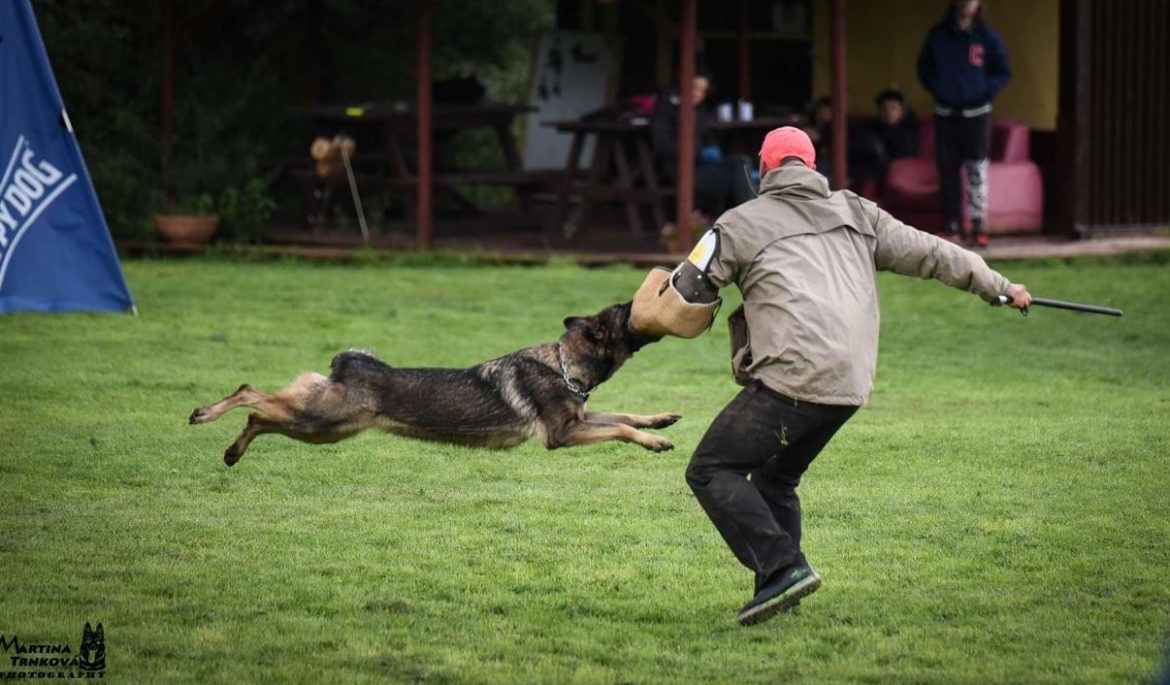The Distinctives of Czech Shepherds Over American Show Line German Shepherds
The German Shepherd Dog (GSD) is a breed developed to excel in obedience, tracking and protection. Increasingly, many experts describe the breed as consisting of two distinct lines— these being the show and working lines. Each of these lines were developed for specific purposes and with different breeding philosophies. Within the working lines, both Germany and the Czech Republic are known for producing some of the highest caliber working lines to be found in the world. While recognizing the contribution of German breeders to the development of the working line, this article limits its focus to comparing and contrasting the kind of Czech working line German Shepherds for sale with their American show line counterparts. While these dogs share a common ancestry, these lines have diverged significantly in terms of physical characteristics, temperament, health, and utility. This article explores the distinctive features of Czech Shepherds compared to American counterparts. We at Czech Working Line unashamedly limit our focus to the working lines. We trust why we do this will be clear as you read through this article and others we have published here on our website. Without a doubt, we are convinced the working lines, especially some of the higher end Czech dogs are some of the most desirable protection dogs to be found on the planet!
Breeding Purpose and Philosophy of the Czech Working Line German Shepherds
The breeding philosophies behind Czech Shepherds and American line AKC German Shepherds highlight their primary differences. Czech Shepherds were developed during the Cold War era. These dogs were the result of rigorous selection, having been bred to work in border patrols, police, and military roles. The emphasis for these dogs was on functionality, strength, endurance, and a stable temperament. Breeders focused on dogs that could perform in demanding environments and under high-stress situations. This resulted in dogs with robust health, high drive, and excellent working capabilities. Here at Czech Working Line we continue to strive to build on these ideals. We believe if we are going to offer a Czech working line German Shepherd for sale, it ought to be the best. It ought to from day one act like a plug and play pup. Kudos to my good friend Ollie for this apt description of our dogs. Ollie just bought his second pup from us. Both of his pups were from IGP3 titled males we own. I just love Ollie’s description of our dogs as “plug and play.” They are genetically wired to serve and protect. Its in their DNA.
In contrast to the working lines, the American show line German Shepherds have been bred primarily for conformation shows and companionship. The American Kennel Club (AKC) breed standard places significant emphasis on appearance. This show focus includes striving for a sharper angle of the hindquarters than would be common in the working lines (those of you who have studied any kind of engineering will get it why the working lines are so committed to keeping this kind of breeding out of the working lines), coat color, and overall symmetry. As many working line purists contend, show dogs often prioritize physical traits over working abilities. This focus on aesthetics has led to a different set of traits and sometimes compromised health and functionality. As working dog enthusiasts, we feel if your main goal is companionship, then get a Poodle or a Yorkie. GSDs were bred for more. They were bred to excel in obedience, tracking and protection. So lets keep that focus front and center as we work to build this breed! Our commitment as we offer Czech working line German Shepherds for sale is to continue the old world focus not just on appearance and health, but on the skills these dogs were bred to express.
Physical Characteristics
Czech Shepherds and American line AKC German Shepherds exhibit notable differences in their physical appearances due to their distinct breeding goals. Czech Shepherds tend to have a more rugged and robust appearance. They are generally more muscular, with a straight back and a balanced build that supports their working roles. Their coat is often denser and more suited to various weather conditions, reflecting their heritage as outdoor working dogs.
American line AKC German Shepherds, on the other hand, often display a more refined and elegant appearance. They are characterized by a more pronounced angulation in the hindquarters, which is a feature highly prized in the show ring. This extreme angulation can sometimes lead to a sloping back, which has been associated with health issues such as hip dysplasia and mobility problems. The coat of American line Shepherds can vary, but it is often bred to be aesthetically pleasing with a softer texture and a variety of color patterns.
Temperament and Behavior
The temperamental differences between Czech Shepherds and American line AKC German Shepherds are significant and stem from their respective breeding purposes. Czech Shepherds are known for their high drive, focus, and intensity. They are bred to be highly trainable, resilient, and capable of handling stressful situations. These traits make them excellent for roles in police work, search and rescue, and military applications. Their temperament is characterized by a strong work ethic, loyalty to their handler, and a balanced demeanor that allows them to perform tasks efficiently.
American line AKC German Shepherds, while still intelligent and trainable, are often bred with a focus on companionship. Most working line German Shepherds consider such a focus to be somewhat akin to buying a Ferrari, but then installing a governor that prevents the car from travelling faster than forty-five miles an hour. Why would a person do that? With muted drive, the show lines have arguably been stripped of their greatness, the horsepower that makes these exotic animals a mere shell of their original capacity!
Health and Longevity
Health is a crucial factor where Czech Shepherds often have an edge over American line AKC German Shepherds. Due to the rigorous selection process focused on working capabilities and genetic diversity, Czech Shepherds generally enjoy better overall health and longevity. Breeders in the Czech Republic prioritize functional traits and robust health, conducting thorough health screenings to minimize genetic disorders. As a result, Czech Shepherds often have lower incidences of conditions like hip dysplasia, elbow dysplasia, and degenerative myelopathy.
In contrast, the focus on aesthetic traits in American line AKC German Shepherds has sometimes led to health compromises. The extreme angulation of the hindquarters, while visually striking in the show ring, has been linked to increased rates of hip and elbow dysplasia. Additionally, the narrowed gene pool due to selective breeding for show qualities can exacerbate the prevalence of genetic disorders. Responsible breeders in the American lines do conduct health testing, but the emphasis on appearance can sometimes overshadow these efforts.
Working Abilities
Czech Shepherds are bred for their exceptional working abilities, making them highly sought after for various demanding roles. Their strong drive, intelligence, and physical endurance make them ideal for police work, military applications, search and rescue, and protection work. They excel in these roles due to their ability to maintain focus, respond quickly to commands, and perform under pressure. The intensive training and selection for these traits ensure that Czech Shepherds are reliable and effective working dogs.
American line AKC German Shepherds, while still capable of performing many tasks, often do not match the same level of working prowess as their Czech counterparts. Their breeding for conformation shows means they are less likely to be selected for roles requiring high endurance and resilience. However, they still retain the intelligence and trainability of the breed, making them suitable for various roles such as therapy work, service dogs, and general companionship.
Czech German Shepherds Bred to Thrive in Harsh Conditions
Czech Shepherds, with their history of working in various harsh environments, are highly adaptable and resilient. They can thrive in a wide range of settings, from urban areas to rural landscapes, as long as their physical and mental stimulation needs are met. Their robust health and balanced temperament allow them to handle different climates and challenging conditions effectively. This adaptability makes them suitable for active families, individuals seeking working dogs, and professionals in need of reliable working partners.
American line AKC German Shepherds are also adaptable but in different ways. Their temperament and physical traits make them well-suited for family life and urban living. They generally require less intense physical activity compared to Czech Shepherds, making them suitable for households with moderate activity levels. However, they still need regular exercise and mental stimulation to prevent boredom and behavioral issues. Their adaptability to different family dynamics and environments makes them popular choices for companion pets.
Conclusion
The distinct differences between the Czech working line German Shepherds for sale that we produce and many of the American line AKC German Shepherds highlight the impact of breeding philosophies and purposes. Czech Shepherds, with their focus on working capabilities, robust health, and adaptability, excel in demanding roles and environments. In contrast, American line AKC German Shepherds, bred for conformation shows and companionship, offer a more refined appearance. Isn’t it selling the breed short if we reduce these great and noble dogs to companion dogs?. Understanding these differences is crucial for prospective owners to make informed decisions based on their needs, lifestyle, and the intended role of their German Shepherd.
Bibliography
- Budiansky, Stephen. The Truth About Dogs: An Inquiry Into the Ancestry, Social Conventions, Mental Habits, and Moral Fiber of Canis Familiaris. Viking, 2000.
- Coren, Stanley. The Intelligence of Dogs: A Guide to the Thoughts, Emotions, and Inner Lives of Our Canine Companions. Bantam Books, 1994.
- Dibra, Bashkim, and Randolph, David. Dog Training by Bash. Dutton, 1992.
- Hart, Benjamin L., and Hart, Lynette A. Canine Behavior and Training: Historical and Modern Perspectives. Iowa State University Press, 1985.
- Jemmett, Stephen. The Czech German Shepherd: History and Heritage. Heritage Publishing, 2017.
- Miklósi, Ádám. Dog Behaviour, Evolution, and Cognition. Oxford University Press, 2007.
- Ostrander, Elaine A., Galibert, Francis, and Patterson, Donald F. “Canine genetics comes of age.” Trends in Genetics, vol. 16, no. 3, 2000, pp. 117-124.
- Schutz, Resi. Protection Dog Training: An Owner’s Manual. Howell Book House, 2001.
- Serpell, James. The Domestic Dog: Its Evolution, Behaviour and Interactions with People. Cambridge University Press, 1995.
- Willis, Malcolm B. Genetics of the Dog. Howell Book House, 1991.
- Wilson, P. J., and Ogilvie, G. K. Canine and Feline Nutrition: A Resource for Companion Animal Professionals. Mosby, 1998.
- Zink, Michael C. Peak Performance: Coaching the Canine Athlete. Dogwise Publishing, 2005.




